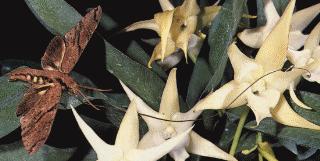The predicted moth The predicted moth
In 1862, the famous naturalist Charles Darwin published a book on the evolutionary biology of orchids, On the Various Contrivances by which British and Foreign Orchids are Fertilised by Insects. Studying the angraecoids, he remarked that they were pollinisated by specific insects. One of these orchids from Madagascar, Angraecum sesquipedale, had nectaries eleven and a half inches (28.6 cm) long, with only the lower inch and a half (3.8 cm) filled with nectar. From the structure of this orchid, Darwin "predicted" the existence of an unknown moth :
"It is, however, surprising that any insect should be able to reach the nectar : our English sphinxes have probosces as long as their bodies ; but in Madagascar there must be moths with probosces capable of extension to a length of between ten and eleven inches !" (Darwin 1862).
Charles Darwin (1809-1882)
Darwin then made an experiment. He took a cylinder, one-tenth of an inch (2.5 mm) in diameter, and pushed it down through the cleft of the rostrellum :
"By this means alone I succeeded in each case in withdrawing the pollinia ; and it cannot, I think, be doubted that a large moth must thus act ; namely, by driving its proboscis up to the very base, through the cleft of the rostrellum, so as to reach the extremity of the nectary ; and then withdrawing its proboscis with the pollinia attached to it."
This insect would affect of course the fertilization of the orchid, and Darwin concluded to the survival of this moth from ecological evidence :
"The pollinia would not be withdrawn until some huge moth, with a wonderfully long proboscis, tried to drain the last drop. If such great moths were to become extinct in Madagascar, assuredly the Angraecum would become extinct."
In a letter published in the June 12, 1873, issue of Nature, W.A. Forbes asked if readers were aware of such moths in Madagascar, and he proposed an identification :
"They would probably be Sphingidae of some kind, as no other moths would combine sufficient size and length of proboscis." (Forbes 1873).
Herman M??ller, in the July 17 issue of the same year, mentioned that his brother had caught in Brazil a sphinx "the proboscis of which has a length of about 0.25 metres", demonstrating that Darwin's moth was not at all impossible (M??ller 1873). In the second edition of his book (1877), the father of natural selection remarked :
"This belief of mine has been ridiculed by some entomologists, but we now know from Fritz M??ller that there is a sphinx-moth in South Brazil which has a proboscis of nearly sufficient length, for when dried it was between ten and eleven inches long. When not protruded it is coiled up into a spiral of at least twenty windings." (Darwin 1877).
Meanwhile, Alfred Russel Wallace (figure 2), the father of biogeography, commented at greater length on this orchid, firstly in an article for the Quarterly Journal of Science (1867), then in his book Contributions to the Theory of Natural Selection (1871), and he came to the same conclusion :
"I may here mention that some of the large sphinx moths of the tropics have probosces as long as the nectary of Angraecum sesquipedale. I have carefully measured the proboscis of a specimen of Macrosilia cluentius [=Cocytius cluentius] from South America, in the collections of the British Museum, and find it to be nine inches and a quarter long ! One from tropical Africa (Macrosilia morgani) [=Xanthopan morgani] is seven inches and a half. [...]. That such a moth exists in Madagascar may be safely predicted ; and naturalists who visit that island should search for it with as much confidance as astronomers searched for the planet Neptune, and I venture to predict they will be equally successful !" (Wallace 1867, 1871).
Alfred Russel Wallace (1823-1913)
This last remark alluded to German astronomer Galle, who had searched for, and found, the planet Neptune, after French mathematician Le Verrier predicted its existence and position, from calculations on the orbite of Uranus, the then last known planet of the solar system -- a well-known case in the history of sciences, often mentioned for its significance in epistemology.
And the idea of a close relation with the large sphingid of tropical Africa, Xanthopan morgani, which has a proboscis about 20 cm, was quite judicious and prophetic. This "cryptolepidoptere" was actually found and described 41 years after Darwin's prediction : it belonged to that very species, but it was a new sub-species, which Rothschild and Jordan named Xanthopan morgani praedicta in 1903, i.e. "predicted",which is fully justified (Rothschild and Jordan 1903). This insect has a wing span of 13 to 15 cm, of the color of a dead leaf and its proboscis is actually 25 cm (ten inches) long (figure 3).
[Photo] The moth Xanthopan morgani praedicta and the star orchid Angraecum sesquipedale (photograph : Marcel Lecoufle)
This contribution to cryptozoology is remarkable, as it concerns the prediction, from phytobiology and ecology (i.e. from circumstancial evidence only), of an unknown moth (at the level of the subspecies), the existence and the identification of which have been experimentally confirmed a posteriori. This should be considered an important victory of a true cryptozoological mind, shared at least by two of the greatest naturalists of the nineteenth century, to wit Darwin and Wallace.
From Institut Virtuel de Cryptozoologie http://perso.wanadoo.fr/cryptozoo/dossiers/moth.htm
